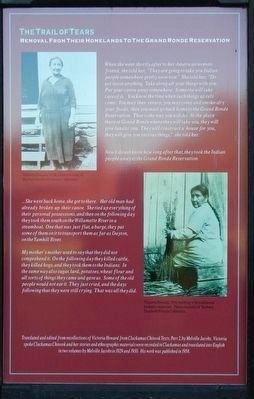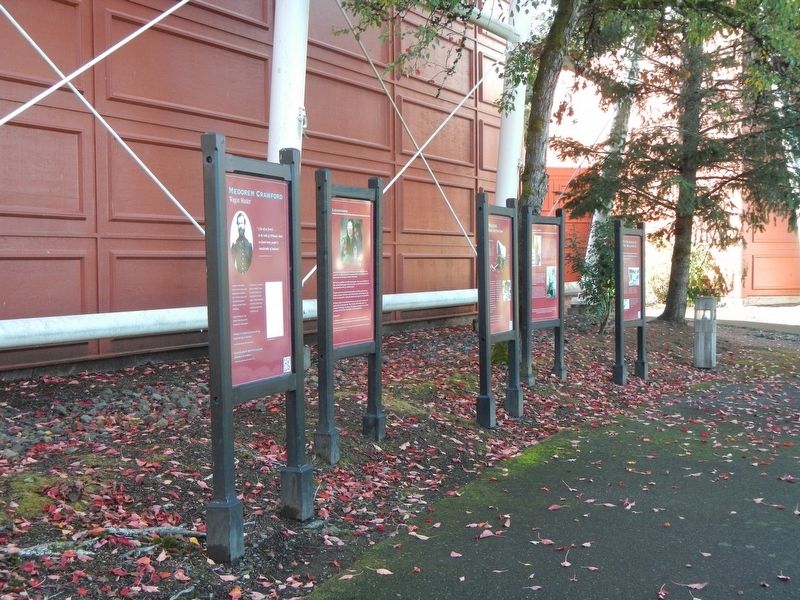Oregon City in Clackamas County, Oregon — The American West (Northwest)
The Trail of Tears
Removal From Their Homelands To The Grand Ronde Reservation
Inscription.
When she went shortly after to her American woman friend, she told her, "They are going to take you Indian people somewhere pretty soon now." She told her, "Do not leave anything. Take along all your things with you. Put your canoe away somewhere. Someone will take care of it. You know the time when such things as eels come. You may then return, you may come and smoke-dry your foods, then you must go back home to the Grand Ronde Reservation. That is the way you will do. At the place there at Grand Ronde where they will take you, they will give land to you. They will construct a house for you, they will give you various things." she told her.
Now I do not know how long after that, they took the Indian people away to the Grand Ronde Reservation.
…She went back home, she got to there. Her old man had already broken up their canoe. She tied up everything of their personal possessions, and then on the following day they took them south on the Willamette River in a steamboat. One that was just flat, a barge, they put some of them on it to transport them as far as Dayton, on the Yamhill River.
My mother's mother used to say that they did not comprehend it. On the following day they killed cattle, they killed hogs, and they took them to the Indians. In the same way also sugar, lard, potatoes, wheat flour and all sorts of things they came and gave us. Some of the old people would not eat it. They just cried, and the days following that they were still crying. That was all they did.
Translated and edited from recollections of Victoria Howard from Clackamas Chinook Texts, Part 2, by Melville Jacobs. Victoria spoke Clackamas Chinook and her stories and ethnographic materials were recorded in Clackamas and translated into English in two volumes by Melville Jacobs in 1929 and 1930. His work was published in 1958.
Erected by End of the Oregon Trail Interpretive Center.
Topics and series. This historical marker is listed in this topic list: Native Americans. In addition, it is included in the Trail of Tears series list. A significant historical year for this entry is 1929.
Location. 45° 21.863′ N, 122° 35.69′ W. Marker is in Oregon City, Oregon, in Clackamas County. Marker can be reached from Washington Street near Abernethy Road, on the right when traveling north. Touch for map. Marker is at or near this postal address: 1726 Washington Street, Oregon City OR 97045, United States of America. Touch for directions.
Other nearby markers. At least 8 other markers are within walking distance of this marker. Wagons (here, next to this marker); To The Banks Of The Willamette (here, next to this marker); Clackamas Chinook (a few steps from this marker); Dr. John McLoughlin (a few steps from this marker); Oregon (a few steps from this marker); Medorem Crawford (a few steps from this marker); The Confederate Tribes of Grande Ronde Today (a few steps from this marker); Sidney W. Moss (a few steps from this marker). Touch for a list and map of all markers in Oregon City.
More about this marker. This marker is located next to the End Of Oregon Trail Interpretive Center facing outward towards Abernethy Green
Credits. This page was last revised on December 12, 2022. It was originally submitted on February 16, 2018, by Barry Swackhamer of Brentwood, California. This page has been viewed 273 times since then and 21 times this year. Last updated on March 9, 2018, by T. Patton of Jefferson, Georgia. Photos: 1, 2. submitted on February 16, 2018, by Barry Swackhamer of Brentwood, California. • Andrew Ruppenstein was the editor who published this page.

